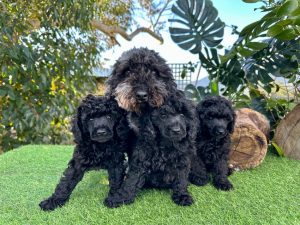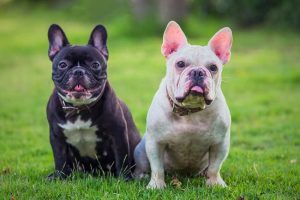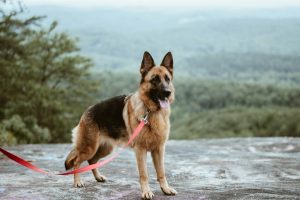The Rottweiler (or “Rottie” for short) is one of the most famous dog breeds worldwide, known for its powerful, imposing appearance and its loyal, excellent protective nature. Loved not only for its persistent working ability but also for its intelligence and trainability, the Rottweiler is a wonderful companion for families and a reliable guard dog. In the article below, Know All Animals will provide a detailed and comprehensive look at the Rottweiler breed, including its origin, physical characteristics, temperament, care, and detailed pricing.
Rottweiler Breed at a Glance
- Breed Group: Working Dog
- Origin: Germany
- Height: 58-69 cm (23-27 inches)
- Weight: 38-50 kg (85-110 lbs) (depending on gender)
- Coat Color: Black with rust or mahogany markings
- Lifespan: 8-10 years
- Temperament: Loyal, protective, confident, calm, courageous
- Best Suited For: Experienced owners, large spaces, families needing a guard dog
- Price: 7 – 50 million VND depending on type and origin
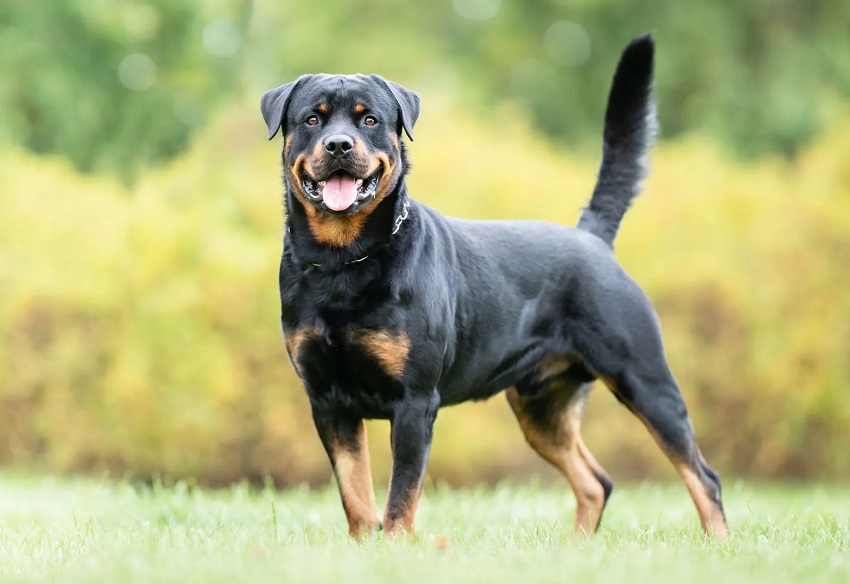
1. Origin and History of the Rottweiler
The Rottweiler is an ancient breed with a long and rich history dating back to the time of the Roman Empire. With its strong protective instincts, loyalty, and superior strength, the Rottweiler has journeyed from a historical working dog to a beloved and reliable companion in many modern families.
1.1. Origin in the Roman Empire
The Rottweiler’s origins trace back to the Molossus-type dogs—large and muscular canines—used by the Roman legions. Over 2,000 years ago, the ancestors of the Rottweiler were used to drive and protect cattle as the Roman legions marched through the lands they conquered. Specifically, on their journey through the Alps into what is now Germany and Switzerland, these dogs played a crucial role in protecting livestock from robbers and wild animals, while also assisting soldiers by pulling carts and carrying goods.
When the Roman army settled in the area that is now the town of Rottweil, Germany, these dogs continued to be used to protect the markets, livestock, and property of the local people. Here, the breed began to develop and gradually became an important part of the region’s economic and social life.
1.2. Development in the City of Rottweil
After the fall of the Roman Empire, the Rottweil area (now in southern Germany) became an important trading center. As a major hub for commerce, Rottweil became the place where this breed flourished. Here, the Rottweiler became known as the “Rottweiler Metzgerhund,” which means “butcher’s dog of Rottweil.” This name came from the breed’s important role in protecting herds of cattle and pulling carts of meat to market.
Rottweilers not only helped herd livestock to the market but also guarded the merchants’ money by wearing money pouches around their necks. With their strength and protective nature, these dogs made robbers wary, helping to protect the property and livestock of the local people.
In addition to their work at markets and butcher shops, Rottweilers were also used to pull carts of goods, herd livestock, and guard homes against thieves.
1.3. Development of Rottweilers in the United States
The Rottweiler breed was introduced to the United States in the early 20th century. German immigrants brought these dogs with them, and they quickly attracted the attention of American dog lovers. In 1931, the Rottweiler was officially recognized by the American Kennel Club (AKC), and the breed became one of the most beloved dogs.
By the mid-1990s, the Rottweiler rose to become the second most popular dog breed in the U.S., thanks in part to its protective capabilities as well as its affectionate and loyal nature with families. The combination of its protective ability and lovable personality has helped the Rottweiler become one of the most popular choices for families seeking both security and companionship.
2. Physical Characteristics of the Rottweiler
The Rottweiler has a large, sturdy, and powerful appearance with a robust body, making it well-suited for demanding tasks such as guarding, carting, or herding. The balance between strength and agility allows this breed to excel in sports and protective duties.
2.1. Size
- Height: Male Rottweilers stand between 61–69 cm (24–27 inches), while females are 56–63 cm (22–25 inches) tall.
- Weight: Males typically weigh 50–60 kg (110–132 lbs), and females weigh 35–48 kg (77–106 lbs).
- Head: A Rottweiler’s head is large, broad, and blocky, with a slightly curved forehead. Their muzzle is wide and strong, showcasing their powerful bite. Their eyes are usually a dark brown color, expressing alertness and intelligence.
- Ears: Rottweiler ears are triangular, moderately sized, and hang down on the sides of the head. When they are focused, their ears may turn slightly forward, adding to the breed’s sharp appearance.
2.2. Body Structure
- Chest: Broad, deep, and muscular, enhancing the Rottweiler’s endurance and stamina. The chest is deep and well-sprung, especially in males.
- Abdomen: The abdomen is tucked but not excessively so, creating a balanced look with the broad chest.
- Legs: Rottweiler legs are strong and well-muscled, particularly the hind legs, which give them powerful running and jumping abilities. The front legs are straight, and the paws are round with a moderate thickness, allowing the dog to move nimbly.
- Tail: According to the standards of some countries, a Rottweiler’s tail may be docked (cut short) from a young age, while in other countries like Germany, the tail is kept natural, long enough to reach the hocks, and carried horizontally along the body.
2.3. Coat and Color
- Coat: Rottweilers have a double coat consisting of two layers: a topcoat and an undercoat.
- Topcoat: Short, straight, coarse, and slightly rough, protecting the dog from harsh weather conditions.
- Undercoat: Thinner, softer, and dense, helping to keep the body warm, especially in colder climates.
- Rottweilers shed moderately throughout the year but shed more heavily in the spring and fall during seasonal changes.
- Color and Markings: The characteristic color of a Rottweiler is black with distinct rust-colored markings in specific locations:
- On the Cheeks: The rust markings create prominent lines on the face.
- On the Legs: The rust color appears on both the front and hind legs.
- Chest: There is typically a distinct rust-colored patch on the chest area.
- Above the Eyes and Under the Tail: Rust-colored markings also appear above the eyes and on the underside of the tail.
These markings give the Rottweiler its dignified and recognizable appearance. The Rottweiler’s coat requires careful maintenance but is not as demanding to care for as breeds with long or curly hair.
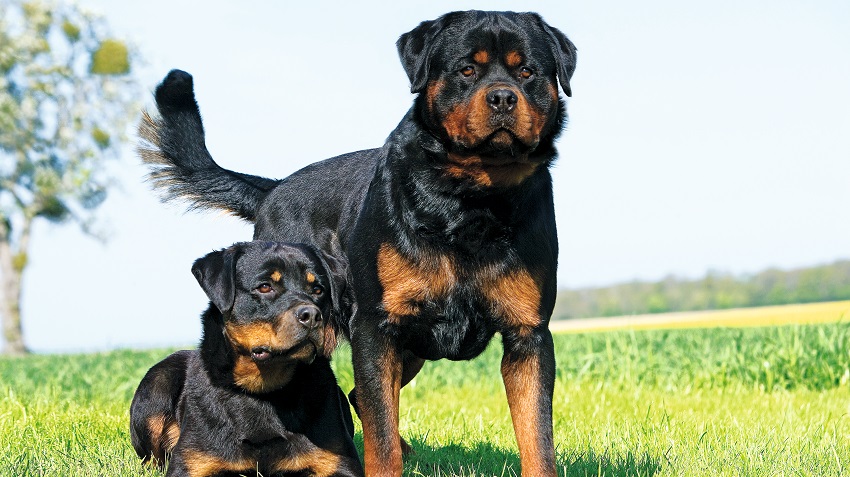
3. Rottweiler Temperament and Behavior
Rottweilers are strong, loyal, and intelligent dogs known for their protective nature and excellent working ability.
- Loyal and Protective: Rottweilers are fiercely protective of their owners and family. However, they can become aggressive if they are not properly socialized from a young age.
- Intelligent and Easy to Train: They are quick learners but require consistent and patient training.
- Confident and Calm: Rottweilers have a steady temperament and are not easily excitable, which makes them great guard dogs.
- Reserved with Strangers: They are naturally cautious around new people and need time to warm up.
- Affectionate with Family: Rottweilers are very loving and gentle with their families, especially with children, if they have been raised and socialized correctly.
- High Energy Needs: They require frequent exercise to prevent destructive behavior caused by boredom.
- Versatile Workers: They excel in a variety of activities, including protection, obedience competitions, and weight pulling.
4. Classification of Rottweilers
4.1. Purebred Rottweilers
Purebred Rottweilers are classified based on several factors. The standard German Rottweiler is typically divided into two types: the Standard Rottweiler and the Large-Type Rottweiler.
- Standard Rottweiler: This is the most common type of Rottweiler today. Originally bred for heavy work like pulling carts, they have since evolved into popular family pets. As adults, they typically weigh 35-60 kg (77-132 lbs) and stand 56-69 cm (22-27 inches) tall.
- Large-Type Rottweiler: Also known as the “heavy-jowled Rottweiler,” these dogs have a physique that is notably larger than others in the breed. As adults, they can reach a weight of 70-80 kg (154-176 lbs) and a height of 70-80 cm (27.5-31.5 inches).
4.2. Rottweiler Mixes
Rottweiler-German Shepherd Mix
Rottweilers and German Shepherds are both top-tier dogs from Germany with many shared characteristics and similar living requirements. Because of this, the crossbreed of these two is highly welcomed. The puppies from this mix often have the physical appearance of a Rottweiler but with a German Shepherd’s body and smooth, lovely fur.
Rottweiler-Doberman Mix
The crossbreeding of two excellent breeds, the Rottweiler and the Doberman, results in a mix that combines all the best traits of both parents. The offspring will inherit the Doberman’s exceptional agility and speed, along with the Rottweiler’s reputation for having a muscular, streamlined, and athletic appearance.
Rottweiler-Phu Quoc Ridgeback Mix
The mix of a Rottweiler and a Phu Quoc Ridgeback is quite common in Vietnam. Creating the ideal crossbreed from these two dogs is not simple, as the offspring’s appearance tends to favor the Phu Quoc Ridgeback more than the Rottweiler.
Rottweiler-Pitbull Mix
In Vietnam, German Rottweilers are also crossbred with Pitbulls to create a new breed with better health and a more striking physique. The cross between a Rottweiler and a Pitbull creates a mix called a Pitweiler, a breed with a very amusing face.
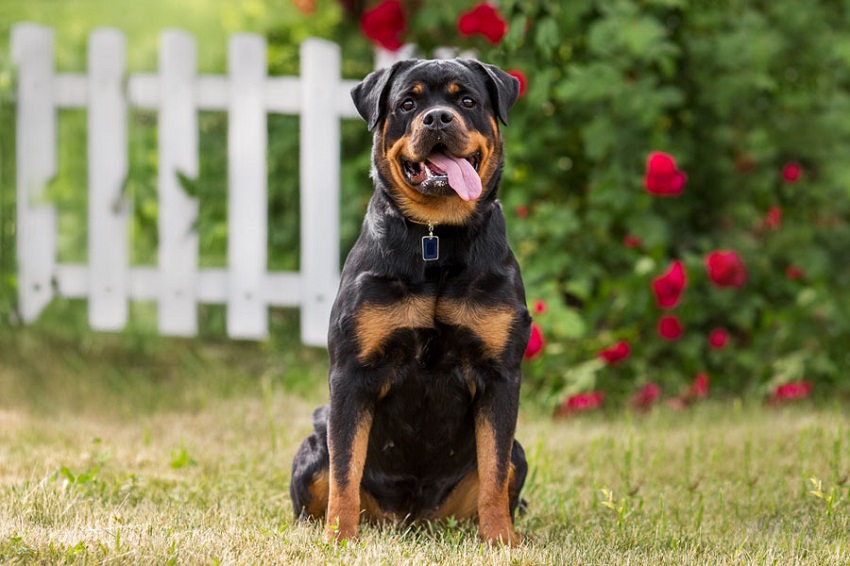
5. How to Care for a Rottweiler
5.1. Living Environment
German Rottweilers can adapt to a variety of living environments. They can live in an apartment or in a large, wild space. However, it’s best to allow your Rottweiler to be active in your yard.
To help your Rottweiler become more friendly, obedient, and sociable, you should create a space that is spacious, well-ventilated, cool in the summer, and warm in the winter. Providing good living conditions will also help them be more agile and resilient when walking, jogging, and playing active games.
5.2. Rottweiler Nutrition
Rottweilers are considered a large breed that consumes a substantial amount of food, so they need a well-balanced diet. A typical Rottweiler’s meal plan should include the following types of food:
- Various animal meats (beef, pork).
- Fish, crab, seafood, and animal organs including intestines, liver, heart, lungs, and kidneys.
- Eggs (chicken, duck).
- Carbohydrates and grains (rice, porridge, biscuits).
- Fiber from vegetables and fruits.
5.3. Nutritional Plan by Age
Rottweilers under 3 months old:
At this age, a puppy’s digestive system is still very weak and sensitive, so care during this stage must be very cautious. You should mince meat finely and cook it with porridge for them. You can also feed them some dry food, but it needs to be soaked to make it soft and easy for them to eat.
You should feed your puppy 5 times a day with powdered or puréed food if you’re cooking it yourself.
Rottweilers 3-5 months old:
You need to add more nutrients to your dog’s diet from foods like vegetables, eggs, and other items. Additionally, to ensure your Rottweiler develops a good physique, you can simmer bones until soft and give them to your dog to eat.
You can feed your puppy 3 meals a day. If they are a hearty eater, you can reduce this to 2 meals a day. You can also give them large bones to chew on to prevent choking.
Rottweilers over 5 months old:
At this point, a Rottweiler can eat a diet similar to an adult dog. The amount of food should be based on their weight and activity level. You should also add more food like heart, liver, and other animal organs.
You only need to feed them 2 meals a day. To check if the amount of food you’re providing is appropriate, place your hands on their ribcage and press gently. If you can feel their ribs, their weight is normal. If you press gently and cannot feel them, your dog is overweight and you need to reduce their food intake and increase their exercise.
5.4. Grooming a Rottweiler
Bathing a large dog is quite a lot of work and requires significant effort, so you only need to bathe your Rottweiler when necessary. This might be after they’ve been playing outside and gotten dirty, or when their fur becomes matted after a long period.
Brush your dog’s coat once a week to remove dead hair.
Brush their teeth two to three times a week to prevent dental diseases and bad breath.
You should start brushing their coat and teeth from a young age, along with positive praise and encouragement, so the dog gets used to it and will be well-behaved during grooming.
Furthermore, keeping your Rottweiler’s living area clean is also very important, as a clean space helps boost your dog’s immune system.
5.5. Training a Rottweiler
When your Rottweiler is 4 months old or older, you should begin training them with light exercises and gradually increase the intensity as they develop.
You should train them every day by taking them on daily walks, practicing fetching a ball, or retrieving objects to help their bones and muscles develop.
This breed is very active and powerful, so it needs a lot of time to play and exercise outdoors.
When your puppy is 7 months old or older, you can start training them with more intense exercises like running, climbing hills, playing frisbee, or pulling a tire.
Rottweilers have an independent and strong-willed nature, so you need to teach your dog commands from a young age to establish their sense of obedience and compliance.
6. Common Health Issues in Rottweilers
6.1. Hip and Elbow Dysplasia
This condition is common in large breeds like Rottweilers. In dogs with hip and elbow dysplasia (HD&ED), the joints develop abnormally and are misaligned. Over time, this leads to joint dislocation and degeneration, causing the dog severe pain with every movement. In advanced cases, your Rottweiler could become lame.
Treatment: Most cases of hip and elbow dysplasia are treated with surgery to open the pelvic framework, after which the surgeon realigns or replaces the degenerated, inflamed bone to stabilize the joint structure.
Prevention: Hip dysplasia is a genetic condition and is very difficult to prevent. The best way to avoid it is to choose a puppy from healthy parents with clear origins from a reputable breeder.
6.2. Osteosarcoma
Osteosarcoma, a type of bone cancer, is a very common and extremely dangerous disease in Rottweilers. It can cause your dog to limp or even become paralyzed. It is often fatal and significantly shortens a dog’s lifespan. Even with treatment, a Rottweiler that is successfully treated for this condition may only live for another two years at most.
6.3. Gastric Dilatation-Volvulus (Bloat)
Bloat is a dangerous condition that has a very high mortality rate if not detected and treated promptly. One of the tell-tale signs is abnormal abdominal swelling. If you press on the upper abdomen, it will feel bloated like a balloon, while the lower abdomen will be hard and rigid. Each time you press, the dog will show signs of intense pain.
Treatment: Because this is such a dangerous condition, if you suspect your dog has bloat, you should take them to a veterinarian immediately for timely treatment. Vets will base their treatment plan on clinical symptoms and an X-ray of the stomach.
6.4. Allergies
When a Rottweiler has an allergy, their skin becomes red and constantly itchy. They will frequently use their teeth to chew and scratch their skin, their eyes and nose will run continuously, and their face and paws will swell and appear reddish.
Treatment: When you notice your Rottweiler has an allergy, you need to find the cause to treat it effectively. You can use supplements like vitamin C or calcium chloride to help alleviate the condition.
6.5. Rottweiler Vaccination Schedule
First Shot: Administered at 6-8 weeks of age after weaning. This is a 5-in-1 vaccine for Parvo, Distemper, Infectious Hepatitis, Kennel Cough, and Parainfluenza.
Second Shot: Administered at 10-12 weeks of age. Note that you should not give this shot earlier than 3 weeks or later than 4 weeks after the first shot. This is a 7-in-1 vaccine that includes the five diseases from the first shot, plus Leptospirosis and Coronavirus.
Rabies Shot: Administered at 13 weeks of age. Note that the rabies shot is not related to the previous vaccines. This shot should be repeated every year.
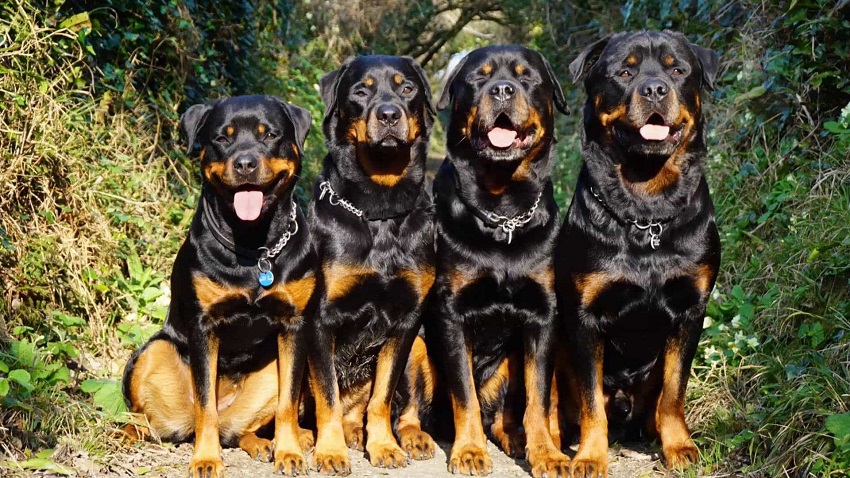
7. Rottweiler Pricing
In Thailand, similar to Indonesia, there are high-quality and reputable breeding kennels. The Rottweiler puppies born here are known for being in good health.
Purebred Rottweilers with purebred parents:
- Standard Rottweilers are priced from $494 – $646 USD.
- Large-Type Rottweilers are priced from $647 – $950 USD.
Rottweilers with official VKA papers: The price is higher, ranging from approximately $760 – $1,191 USD.
Rottweilers imported from Germany: The average price is around $2,000 – $3,000 USD. All of these dogs undergo strict health checks and are certified.
Show-Quality Rottweilers: The price can increase to $3,000 – $5,000 USD for dogs that have won championships in dog shows.
8. FAQs
1. Are Rottweilers good family dogs?
Yes, Rottweilers can be excellent family dogs when properly trained and socialized from a young age. They are loyal, protective, and affectionate with their families, including children.
2. Do Rottweilers require a lot of exercise?
Yes, Rottweilers are energetic dogs that need regular physical and mental stimulation. Daily walks, playtime, and obedience training are essential to keep them healthy and well-behaved.
3. Are Rottweilers aggressive by nature?
Rottweilers are not inherently aggressive, but their strong protective instincts can make them appear intimidating. With proper training, early socialization, and responsible ownership, they are calm and well-mannered companions.
Do you like Rottweilers? Or are there any other dog breeds that impress you? Don’t hesitate to let KnowAllAnimals know and share with everyone how you care for your Rottweiler! We hope you find your best friend.
References: https://en-m-wikipedia-org.translate.goog/wiki/Rottweiler?_x_tr_sl=en&_x_tr_tl=vi&_x_tr_hl=vi&_x_tr_pto=wa

